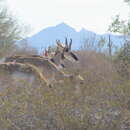en
names in breadcrumbs


Perception Channels: tactile ; chemical
The Sonoran subspecies of pronghorn antelope was listed as endangered on June 2, 1970. Primary threats are habitat destruction due to overgrazing and damming and diversion of rivers. Pronghorn antelope are an endemic American species, whose numbers were severely threatened with the arrival of European settlers. Within 100 years, populations fell from several million to 19,000 animals. Pronghorn antelope are easy prey due to their curiosity. In the winter of 1868-1869, antelope (most likely from the subspecies A. a. americana, found throughout the northern great plains) were transported to various cities by the wagon load between Denver and Cheyenne; 3 to 4 pronghorn were sold as food at prices as low as $.25 (Grzimek 1990). Conservation efforts began at the beginning of the 20th century. When the sale of game meat was outlawed, numbers rose to about 600,000.
US Federal List: endangered
CITES: no special status
Pronghorns move into urban areas and browse on hedges and gardens.
Sonoran Pronghorns were an abundant and accessible food and trophy source for many years.
This species is strictly herbivorous, eating a diet of herbs, cacti, and some desert grasses. Cheek teeth with high crowns are an adaptation to dust-covered, abrasive foods. The Sonoran Pronghorn is a member of the ruminant family, which is characterized by a four-part stomach. This specialized stomach serves as a "fermentation vat": after eating, individuals regurgitate softened cud, which is then chewed again, reswallowed, and finally digested. This digestion system is key in this desert subspecies for a number of reasons. It facilitates the digestion of roughly textured foods such as cacti and desert grasses. It also allows for a high and long retention of both food and water, which is essential in an environment characterized by resource scarcity. Lastly, the stomach lining of ruminant stomachs is highly tolerant of urea, which exists in high concentrations in desert organisms due to highly concentrated urine.
The Sonoran Pronghorn is found in the nearctic region, with a concentration of populations in southwestern Arizona, and some spread into northern Mexico. Although the species Antilocapra americana ranges from southern Canada to northern Mexico, the A. a. sonoriensis subspecies has a very limited range.
The Sonoran Pronghorn inhabits dry plains and desert. In southwestern Arizona, this species is found in broad alluvial valleys separated by granite mountains and mesas. These areas experience excessive winter rains followed by a spring drought, and summer rains followed by autumn drought. The dry, sparsely vegetated landscape is due to the arid climate of this region.
Terrestrial Biomes: desert or dune ; savanna or grassland
Height: ~0.9 m at the shoulder The Sonoran Pronghorn has the characteristic artiodactyl body form. This subspecies has a particularly light build, which contributes to its fast speed; Pronghorns are the fastest North American mammals. Females are roughly 10% smaller than males. All pronghorns have a very short, hardly noticeable tail, ears that are proportional in size to the body and with narrow points, no upper canines, and well-developed scent glands. Both males and females have horns that are specialized with a layer of hornskin covering the bony core. The horns are branched at about 2/3 of the distance between the base and the tip. However, bucks' horns are 30.5 centimeters in length, whereas does' horns are shorter than the ears and often misshapen or even absent altogether. The upperparts of the Pronghorn are a warm tan color, and the neck has a short black mane. The underparts, rump, and 2 bands across the neck are white. Less information is available about Sonoran Pronghorns than about other Antilocapra americana subspecies. However, given that A.a.sonoriensis lives in a very arid climate, it is likely that its physiology is somewhat more adapted to extreme conditions. It must endure higher temperatures, exposure to intense solar radiation, and scarcity of water and food resources. All these conditions call for more thermoregulation and a balance in hydration.
Other Physical Features: endothermic ; bilateral symmetry
Pronghorns have high reproductive rates. This is an adaptation for a short life span of 7 to 10 years, although individuals rarely exceed 9 years. The complex and rigid territoriality systems of bucks break down only during the breeding season. Dominant males court estrus females by offering a sniff of the scent glands located under patches of black hair below the ears. When it comes time to mate, dominant males disappear into hiding places with the estrus females. The male may circle the female with exaggerated steps, alternately flashing the black patches on his right and left cheeks. During this time, younger males move into the herds of non-breeding females. The gestation period for Pronghorns is 250 days. Females often leave their herd to give birth, and will give birth to 1 to 2 young, each of which weighs between 2.25 kg and 3 kg. The young lay hidden; if twins are born, they are kept separately. Young are further protected from predators by their negligible scent; this makes them virtually undetectable in their hiding places. Young Pronghorns are weaned at 4 to 5 months, and reach adult size at 6 months. Sexual maturity occurs at 2 years. At the conclusion of the breeding season, termed the "rut," males shed their horn sheaths and look very similar to females. As they rejoin the female herd, the camouflage of blending in compensates for their post-breeding exhaustion and vulnerability.
Key Reproductive Features: gonochoric/gonochoristic/dioecious (sexes separate); sexual